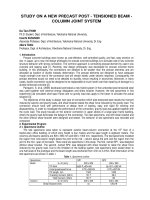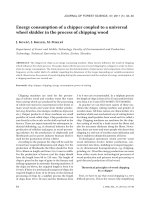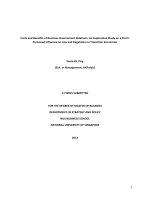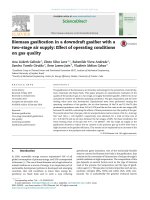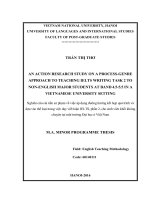Study on predicting the gasification process of acacia wood on a downdraft gasifier: Using the non-stoichiometric equilibrium model
Bạn đang xem bản rút gọn của tài liệu. Xem và tải ngay bản đầy đủ của tài liệu tại đây (616.08 KB, 9 trang )
JOURNAL OF TECHNICAL EDUCATION SCIENCE
Ho Chi Minh City University of Technology and Education
Website: />Email:
ISSN: 2615-9740
Study on Predicting the Gasification Process of Acacia Wood on a Downdraft
Gasifier: Using the Non-stoichiometric Equilibrium Model
Thanh-Luan Nguyen1*, An-Quoc Hoang1, Hung-Duong Hoang2
1Ho
Chi Minh City University of Technology and Education, Vietnam
2Danang University of Technology, Vietnam
*
Corresponding author. Email:
ARTICLE INFO
ABSTRACT
Received:
05/01/2022
Revised:
21/03/2022
Accepted:
06/10/2022
Published:
28/10/2022
KEYWORDS
Biomass;
Gasification;
Downdraft gasifier;
Acacia wood;
Thermodynamic equilibrium.
This study presents a prediction of acacia wood of Vietnam gasification in a
downdraft gasifier based on the thermodynamic equilibrium model.
Analytical solution for the mathematical model obtained by using an EES
(Engineering Equation Solver) program. In the survey, moisture content per
mole of biomass MC= 10 30%, The ratio of the actual amount of oxygen
used for gasification with the amount of oxygen for complete combustion of
the biomass ER= 0.21 0.4. Results indicated that the lower heating value
of syngas decreases with increasing MC or ER. Thermal efficiency tends to
increase with rising ER from 0.21 to 0.374, and it will decrease if ER
continues to increase. The lower heating value of dry products from 4.51 to
6.51 MJ/nm3, the heat efficiency from 49.62 to 75.53%. The carbon
conversion factor tends to increase with an increase as MC or ER. The
influence of MC on the carbon conversion factor is insignificant. The content
of CO2 and CH4 increased, the content of CO decreased with increased MC
or ER. The composition of H2 increases as MC increases while the H2
component increases slightly and then decreases with increasing ER.
Doi: />Copyright © JTE.
This is an open access article distributed under the terms and conditions of the Creative Commons Attribution-NonCommercial 4.0
International License which permits unrestricted use, distribution, and reproduction in any medium for non-commercial purpose, provided the original work is
properly cited.
1. Introduction
Environmental pollution, climate change, and fossil fuel depletion are significant challenges facing
humanity. Using renewable energy is a sustainable development direction in the future. Biomass is
assessed to have great potential and low impact on the environment, and it can replace fossil fuels.
Biomass energy can be converted to product by biological or thermochemical processes.
Thermochemical conversion is in three forms: combustion, pyrolysis, and gasification. Gasification is a
biomass conversion technology by partially oxidizing into a gaseous mixture. The conversion rates of
this technology are evaluated to be higher than combustion and pyrolysis. Gasification is a favorable
solution to reuse biomass solids. Gasification is a complex process and is affected by several parameters
such as biomass composition, temperature gasification zone, gasifying agent, moisture of biomass, etc.
Various gasification models have been considered, such as kinetic models, computational fluid
dynamics models, and thermodynamic equilibrium models to predict the gasification process of
biomass. The thermodynamic equilibrium model is widely used because of its simplicity and less
computation time. There are two types of thermodynamic equilibrium models: the stoichiometric and
non-stoichiometric models. The stoichiometric equilibrium model is built when considering chemical
reactions reach equilibrium, and the equilibrium constants need to be determined to solve this model,
while the non-stoichiometric model uses Gibbs free energy minimization to estimate the equilibrium
constant [1]. The non-stoichiometric equilibrium model has been used in many studies such as Altafini
et al. [2], Melgar et al. [3], Haryanto et al. [4], Buragohain et al. [5]. The non-stoichiometric equilibrium
model incorporating the carbon conversion factor has been considered in some studies such as Azzone
et al. [6], Uzair Ayub [1]. Studies show that this model use has predictions quite suitable to the
experiments of some types of biomass.
JTE, Issue 72A, October 2022
10
JOURNAL OF TECHNICAL EDUCATION SCIENCE
ISSN: 2615-9740
Ho Chi Minh City University of Technology and Education
Website: />Email:
In the gasification process, the gasification temperature and product composition are highly
dependent on the amount of oxygen supplied. It is a function of the amount of oxygen supplied to the
gasifier, and this oxygen supply is usually expressed as an equivalence ratio, MR- the ratio of the actual
amount of oxygen used for gasification with the amount of oxygen for complete combustion of the
biomass. If little oxygen is used, some Char is not converted, while if much oxygen is used, more
combustion occurs, and the temperature increases significantly [7]. Previous studies showed that
ER=0.25 is the mode in which the efficiency of wood gasification can reach the maximum [7].
Therefore, an equivalence ratio near ER= 0.25 is preferred when operating the gasifier. In the
equilibrium model incorporating the carbon conversion factor, the carbon conversion factor is a simple
correlation with the ER by the empirical, with ER in the range ER = 0.210.4 [6, 8].
Vietnam has a very large acacia growing area with millions of hectares of acacia. Therefore, acacia
wood has great potential for exploitation and gasification to produce electricity or supply industrial
processes. It is necessary to study the gasification process of acacia wood. In this study, a nonstoichiometric equilibrium model incorporating the carbon conversion factor was used to forerun the
trend of the gas composition in the finished gas, thermal efficiency, and lower heating value of the dry
product when gasifying acacia wood on the downdraft gasifier. Previous studies considered ER and
gasification temperature as independent variables to investigate. This study will predict the gasification
process from the point of view of gasification temperature as the dependent variable of ER to investigate
the impact on output parameters and assess the suitability of the model with experimental results
previously published. Furthermore, there will be an evaluation of the application of predictive models
in research and teaching on biomass gasification. This study will investigate the predictions in scope
ER=0.210.4, and initial wood moisture MC=1030%.
2. Biomass gasification model
The main reactions in gasification include [9]:
+ The reaction produces carbon monoxide and hydrogen: C + H2O CO + H2
1
+ The reaction produces metal: C + 2H2 CH4
2
+ The reaction produces carbon monoxide: C + CO2 2CO
3
+ The reaction produces carbon dioxide and hydrogen: CO + H2O CO2 + H2
4
The equilibrium model of gasification is considered with the assumptions:
- Ignore mineral and nitrogen components in biomass.
- Tar and Ash are considered to be inert.
- The inlet temperature of the feedstock and the air is 25°C.
- The pressure of gasification is 101325 N/m2.
- The gasification is considered adiabatic.
The gasification reaction inside the gasifier is considered as follow [10]:
CHaOb + mH2O + nO2 + 3.76nN2 = (1-)C+ xaH2+ xbCO + xcCO2 + xdH2O + xeCH4 + 3.76nN2 5
where xa, xb, xc, xd, xe, (1-) are moles of components in the reaction. m and n are the molar of
water and oxygen per mole of feedstock, respectively.
The carbon conversion factor can be determined as follows [6, 8].
0.32 0.84 1 e ER/0.229 , ER=0.210.4
6
With m and n can be determined by the following equations [10]:
a b
)
4 2
MC(12 a 16b)
m
18(1 MC)
n ER(1
JTE, Issue 72A, October 2022
7
8
11
JOURNAL OF TECHNICAL EDUCATION SCIENCE
Ho Chi Minh City University of Technology and Education
Website: />Email:
ISSN: 2615-9740
where ER is an equivalence ratio- the ratio of the actual amount of oxygen used for gasification with
the amount of oxygen for complete combustion of the biomass, MC is initial moisture content of
feedstocks.
The balanced equation of the components in the reaction are determined:
+ For carbon: xb+xc+xe=
9
+ For Hydrogen: 2m+a=2xa+2xd+4xe
+ For Oxygen: m+ b+2n=xb+2xc+xd
The equilibrium constant for methane formation [10]:
10
11
k1
xe .xt
xa2
12
where
xt x a xb x c x d x e
13
The equilibrium constant for water–gas shift [10]:
k2
xa xc
xb xd
14
The equilibrium constant k1 and k2 can be determined [11]:
ln k1 7082.842T 1 6.567lnT 3.7335.103 T 3.61167.107 T 2 35050.T 2 32.541 15
ln k2 5878T 1 1.86lnT 0.27.103 T 58200T 2 18
16
Heat balance equation for gasification (considered adiabatic) [11]:
o
o
Hbiomass mH Ho 2O,l Hvap n.HOo2 3,76n.H No 2 (1 ) HCo xa H Ho 2 xb HCO
xc HCO
xd H Ho 2O, g
2
o
xe HCH
[(1 )c p,C xa c p, H2 xbc p,co xc c p,CO2 xd c p,H2O xec p,CH4 3,76nc p,N2 ]T
4
17
o
o
where cp,i, Hi , Hbiomass, H H2O,l , and Hvap are specific heat, heat formation, heat formation of
biomass, heat formation of liquid water, and heat of vaporization of water, respectively.
The specific heat of the components is determined [11]:
C
D
2
c p R( A BTam (4Tam
T1T2 )
)
3
T1T2
18
where A, B, C, and D are constants for the components (see [11]), T1, T2, and R are the ambient
temperature, gasification temperature, and universal gas constant, respectively.
The heat formation of biomass (CHaOb) is calculated as follows [11]:
o
H biomass H CO
2
a o
H H 2O LHVbiomass
2
The lower heating value (LHVbiomass) of the feedstocks can be estimated by [12]:
19
LHVbiomass 0.0041868 0.00062802[O] 7837.667[C] 33888.889[ H ] 0.125[O]
20
where [C], [H], [O], and [A] are the ultimate analysis of C, H, O, and Ash, respectively.
To evaluate the accuracy of the model, the root mean square (RMS) error was used [10]:
( A
Ap )2
21
Y
where Ae, Ap, and Y are the result of experiment, result of predicted, and number of experiments
performed, respectively.
RMS
e
JTE, Issue 72A, October 2022
12
JOURNAL OF TECHNICAL EDUCATION SCIENCE
Ho Chi Minh City University of Technology and Education
Website: />Email:
ISSN: 2615-9740
The volume percent of the dry syngas is calculated as follows:
[Vi ]
xi
22
4
x
i 1
i
where xi are the moles of H2, CO, CO2, CH4
Lower heating value (LHVgas, MJ/Nm3 ) of dry product is estimated [13]:
LHVgas 4.2(3[VCO ] 2.57[VH 2 ] 8.54[VCH 4 ])
23
The heat efficiency of the gasifier (efficiency of cold gas) can be estimated as follows [10]:
LHVgas
22.4 xtotal
24
.
M bm
LHVbiomass
where Mbm is inlet mass of biomass, xtotal is moles of the dry syngas
The sets of equations (6-24) were solved by the EES software (Engineering Equation Solver) to
determine the variables in the 19 equations above. This program allows solving sets of equations,
including linear and nonlinear equations, simply and quickly. The algorithm flowchart used to survey
the parameters in this study is shown in Figure 1.
Figure 1. Algorithm Flowchart to solve the problem
The analysis for wood: [C] (50%), [H] (6%), [O] (44%), [N] (0%), [A] (0%), carbon conversion
factor =1 and the gasification temperature T=800C was performed to verify the mathematical model.
The results show that the volume percent of gases in the present study is in good agreement with
published data [11] (Figure 2). Thus, the calculation program can be trusted to predict gasification for
acacia wood.
JTE, Issue 72A, October 2022
13
JOURNAL OF TECHNICAL EDUCATION SCIENCE
Ho Chi Minh City University of Technology and Education
Website: />Email:
ISSN: 2615-9740
Figure 2. Validation with published result [11]
3. Results and Discussion
The gasification predictions in this study were performed for acacia wood with property parametric
shown in Table 1. Table 2 shows the comparison between the predicted results and the experimental
results. The results show that the model that assesses the carbon conversion factor has RSM = 11.7,
while the model with a carbon conversion factor of 1 has RSM = 12.8. That shows that the carbon
conversion factor model has a more accurate prediction. In addition, this model also predicts the
gasification zone temperature of 630.2C, which is relatively consistent with the experimental results.
Table 1. Property of Acacia wood [14]
Parameter
Weight percent , %
Carbon
47.68
Hydrogen
5.17
Oxygen
44.38
Nitrogen
0.37
Other
2.38
Ash
0.3
Table 2. Comparision between model and experimental result of acacia wood chip at MC=16% and ER=0.3
Model present
Component
Non-using the carbon
conversion factor
Using the carbon
conversion factor
Experimental
[14]
H2
19.32
20.4
14.77
CO
16.87
15.78
11.81
CH4
4.526
3.33
1.27
CO2
15.54
15.67
18.57
N2
43.75
44.83
53.59
LHV [MJ/nm3]
5.83
5.38
3.69
Temperature of
reduction zone
601C
630.2C
630670C
JTE, Issue 72A, October 2022
14
JOURNAL OF TECHNICAL EDUCATION SCIENCE
ISSN: 2615-9740
Ho Chi Minh City University of Technology and Education
Website: />Email:
Figure 3 shows the effect of moisture content (MC) on the component of the gas product, LHVgas,
and the heat efficiency of acacia wood gasification corresponding to ER=0.25. The tendency of the gas
components is shown in Figure 3a. The results show the H2, CH4, and CO2 components increase while
CO decreases follow uptrend MC. The possible explanation for this tendency is that an increase in the
MC increases the H2O content in the gasification zone, which leads to an increased shift reaction. Figure
3b shows that when MC increases from 10 to 30%, the heat efficiency decreases from 68.88 to 51.92%,
LHVgas reduces from 6.02 to 5.65 MJ/nm3. This remark is consistent with the report [11].
Figure 3. Effect of MC on gasification: (a) Effect of MC on the component of the gas product; (b) Effect of
MC on LHVgas and the heat efficiency of the gasifier
The effect of ER on acacia wood gasification in case MC=20% can be seen in Figure 4. The result
shows that the CH4 and CO2 components decrease while CO increases with an increase in ER. The H2
composition increased slightly initially, then decreased with increasing ER (see Figure 4a). It can be
explained that by increasing the ER, the gasification temperature increases, thereby increasing the
carbon conversion factor and increasing the CO generation reaction. Moreover, the gasification process
tends to switch to combustion, so the component gas H2 and CH4 decreases. The increase of CO does
not compensate for the decrease of CH4 and H2, leading to LHVgas tending to decrease when ER is
increased. It is in good agreement with the conclusions of previous studies [6, 7]. Increasing the ER
from 0.21 to 0.374, the heat efficiency tends to increase and decrease if the ER continues to increase. It
shows that with increasing ER, the number of moles of the product gas increases a lot while LHV gas
decreases less, leading to heat efficiency increases. ER increases over 0.374, the gasification process
shifts powerfully to combustion, so the number of moles of the product gas increases less while LHVgas
decreases more, so heat efficiency tends to decrease. In detail, Figure 4b shows the heat efficiency
increased from 57.61 to 63.76% when ER increased from 0.21 to 0.374, then decreased to 63.51% when
ER increased to 0.4; LHVgas reduced from 6.29 to 4.51 MJ/nm3 when ER increased from 0.21 to 0.4.
Figure 4. Effect of ER on gasification: (a) Effect of ER on the component of the gas product; (b) Effect of ER
on LHVgas and the heat efficiency of the gasifier
JTE, Issue 72A, October 2022
15
JOURNAL OF TECHNICAL EDUCATION SCIENCE
Ho Chi Minh City University of Technology and Education
Website: />Email:
ISSN: 2615-9740
Figure 5 exposes the overall influence of MC and ER on carbon conversion factor (CCF). The
influence of MC on CCF is negligible. ER has a significant influence on CCF. It can explain that ER
increases, increased oxygen content, accelerated carbon oxidation lead to CCF increases. The carbon
conversion factor is from 0.812 to 0.997.
Figure 5. Effect of MC and ER on carbon conversion factor (CCF)
Figure 6 shows the variation of LHVgas in the survey range with MC=1030% and ER=0.210.4.
The results show that LHVgas is maximum when MC approaches 0.1 and ER approaches 0.21. LHVgas
has a value from 4.51 MJ/nm3 to 6.51 MJ/nm3.
Figure 6. Effect of MC and ER on the lower heating value (LHV gas)
Figure 7 shows the variation of the heat efficiency of the gasification process. The results show that
the heat efficiency is maximal when MC approaches 0.1 and ER approaches 0.374 (results analyzed by
Design-Expert software). The heat efficiency has a value from 49.62 to 72.53%. This is entirely
consistent with the previous analysis.
JTE, Issue 72A, October 2022
16
JOURNAL OF TECHNICAL EDUCATION SCIENCE
Ho Chi Minh City University of Technology and Education
Website: />Email:
ISSN: 2615-9740
Figure 7. Effect of MC and ER on the heat efficiency of the gasifier ()
4. Conclusions
This study presents a prediction of acacia wood of Vietnam gasification founded the thermodynamic
equilibrium model in a downdraft gasifier. The main findings are as follows:
- When MC increased from 10 to 30%, the content of H2, CH4, CO2 increased, the content of CO
decreased.
- When ER increased from 0.21 to 0.4, the content of CH4 and CO2 decreased, the content of CO
increased, the content of H2 initially increased slightly then tended to decrease.
- The carbon conversion factor increased with increased MC or increased ER. The effect of MC on
the carbon conversion factor is negligible.
- LHVgas and heat efficiency decreased with increased MC or increased ER. In the scope of the survey
with ER=0.21 0.4, MC=10 30% then LHVgas = 4.51 6.51 MJ/nm3, =49.62 75.53%.
- An equilibrium model can be used to predict gasification for research and teaching on biomass
gasification.
JTE, Issue 72A, October 2022
17
JOURNAL OF TECHNICAL EDUCATION SCIENCE
Ho Chi Minh City University of Technology and Education
Website: />Email:
ISSN: 2615-9740
REFERENCES
[1]
[2]
[3]
[4]
[5]
[6]
[7]
[8]
[9]
[10]
[11]
[12]
[13]
[14]
Ayub, H.M.U., Park, S.J., and Binns, M., “Biomass to syngas: modified non-stoichiometric thermodynamic models for the downdraft
biomass gasification,” Energies, Vol. 13, No. 21, pp. 5668, 2020. DOI: 10.3390/en13215668.
Altafini, C.R., Wander, P.R., and Barreto, R.M., “Prediction of the working parameters of a wood waste gasifier through an equilibrium
model,” Energy conversion and management, Vol. 44, No. 17, pp. 2763-2777, 2003. DOI: 10.1016/S0196-8904(03)00025-6.
Melgar, A., Perez, J.F., Laget, H., and Horillo, A., “Thermochemical equilibrium modelling of a gasifying process,” Energy conversion
and management, Vol. 48, No. 1, pp. 59-67, 2007. DOI: 10.1016/j.enconman.2006.05.004.
Haryanto, A., Fernando, S.D., Pordesimo, L.O., and Adhikari, S., “Upgrading of syngas derived from biomass gasification: A
thermodynamic analysis,” Biomass and bioenergy, Vol. 33, No. 5, pp. 882-889, 2009. DOI: 10.1016/j.biombioe.2009.01.010.
Buragohain, B., Mahanta, P., and Moholkar, V.S., “Performance correlations for biomass gasifiers using semi‐equilibrium non‐
stoichiometric thermodynamic models,” International Journal of Energy Research, Vol. 36, No. 5, pp. 590-618, 2012. DOI:
10.1002/er.1818.
Azzone, E., Morini, M., and Pinelli, M., “Development of an equilibrium model for the simulation of thermochemical gasification and
application to agricultural residues,” Renewable energy, Vol. 46, No., pp. 248-254, 2012. DOI: 10.1016/j.renene.2012.03.017.
Reed, T.B., and Das, A., Handbook of biomass downdraft gasifier engine systems, ed., Biomass Energy Foundation, 1988.
Damiani, L., and Trucco, A. “Biomass gasification modelling: an equilibrium model, modified to reproduce the operation of actual
reactors,” Turbo Expo: Power for Land, Sea, and Air Conference, Vol. 48821, 2009, pp. 493-502.
doi: 10.1115/GT2009-60323
Puig-Arnavat, M., Bruno, J.C., and Coronas, A., “Review and analysis of biomass gasification models,” Renewable and sustainable
energy reviews, Vol. 14, No. 9, pp. 2841-2851, 2010. DOI: 10.1016/j.rser.2010.07.030.
Lim, Y.-i., and Lee, U.-D., “Quasi-equilibrium thermodynamic model with empirical equations for air–steam biomass gasification in
fluidized-beds,” Fuel Processing Technology, Vol. 128, No., pp. 199-210, 2014. DOI: 10.1016/j.fuproc.2014.07.017.
Zainal, Z., Ali, R., Lean, C., and Seetharamu, K., “Prediction of performance of a downdraft gasifier using equilibrium modeling for
different biomass materials,” Energy conversion and management, Vol. 42, No. 12, pp. 1499-1515, 2001. DOI: 10.1016/S01968904(00)00078-9.
Balmer, R., “Thermodynamics. St. Paul,” MY: West Publishing Co, Vol. No., 1990.
Lv, P., Xiong, Z., Chang, J., Wu, C., Chen, Y., and Zhu, J., “An experimental study on biomass air–steam gasification in a fluidized bed,”
Bioresource technology, Vol. 95, No. 1, pp. 95-101, 2004. DOI: 10.1016/j.biortech.2004.02.003.
Viet, D.Q., “Research on the pyrolysis behaviors of acacia wood and gasification for synthesis gas production, Ph.D thesis, Hanoi
University of Science and Technology, 2018,” No., 2017.
Thanh-Luan Nguyen received B.E. in 2012 from Da Nang University of Technology (Vietnam) and M.E. in 2018
from Ho Chi Minh City University of Technology (Vietnam). He has been a lecturer at the Faculty of Vehicle and
Energy Engineering at Ho Chi Minh City University of Technology and Education since 2018. His research
interests include drying techniques, heat transfer, and CFD.
An-Quoc Hoang, (PhD. at DaNang University, Vietnam) is working as Associate professor and Dean of Research
Management and International Relation Office at Ho Chi Minh City University of Technology and Education. His
research interests are Thermodynamic and Heat transfer and Renewable Energy. He has conducted many research
projects on the applications of solar thermal energy and biomass gasification. He has published twenty-five research
papers in various journals and conferences. He has also published three books in the field of thermal and
refrigeration engineering.
Dr. Hoang Duong Hung (PhD. at DaNang University, Vietnam) is working as Associate professor of Faculty of
Heat and Refrigeration Engineering at University of Science and Technology of The University Of Danang. His
research interests are Thermodynamic and Heat transfer and Renewable Energy. He has conducted many research
projects on the applications of solar thermal energy and Boiler. He has published twenty research papers in various
journals and conferences. He has also published two books in the field of thermal and Solar Energy.
JTE, Issue 72A, October 2022
18


